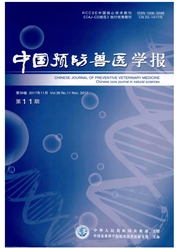

 中文摘要:
中文摘要:
为建立活的非可培养状态(VBNC)研究模型,本研究利用液体LB和4℃联合条件对鸡白痢沙门氏菌CVCC578参考株的进行VBNC诱导,构建VBNC研究模型。同时依靠胎牛血清和程序性升温对处于该状态的菌体进行复苏,并对复苏前后的细菌进行了16SrRNA验证。结果表明:实验菌株经液体LB和4℃联合诱导后,可培养菌数在55d后降至零,总菌数在整个观察期内基本不变,而活菌数在150d后开始下降,180d后下降显著,表明实验菌株可在55d进入VBNC,而且维持时间至180d。当进入该状态后,菌体形态可由杆状变为球杆或球形,并且菌体排列可由单在变为聚集。经复苏和16SrRNA鉴定后,"变态"的细菌被证实为沙门氏菌,而非杂污染菌。该实验为规范VBNC沙门氏菌的鉴定程序以及制订相应的国家检测标准提供了实验依据。
 英文摘要:
英文摘要:
In this study,the viable but non-culturable (VBNC) Salmonella pullorum CVCC578 standard strain was induced in LB medium at 4 ℃ in order to establish a model for VBNC bacteria identificaction and detection. VBNC Salmonella pullorum was resuscitated with fetal bovine serum and gradient incubated temperatures,and resuscitation and non-resuscitation of bacteria were identified by the presence of 16S rRNA. The results showed that the culturable counts of Salmonella pullorum decreased to zero by 55 days inducing. The total counts were unchanged with the prolonged inducing time,however viable count rapidly decreased by 180 days. The Salmonella pullorum strain entered VBNC at 55 days and non-culturable cells remained viable for up to 180 days. Cell shape changed from bacilus to coccus and cell alignment also changed from existing alone to gathering into VBNC. This studies established the foundation for VBNC cells identificaction and detection standard.
 同期刊论文项目
同期刊论文项目
 同项目期刊论文
同项目期刊论文
 期刊信息
期刊信息
